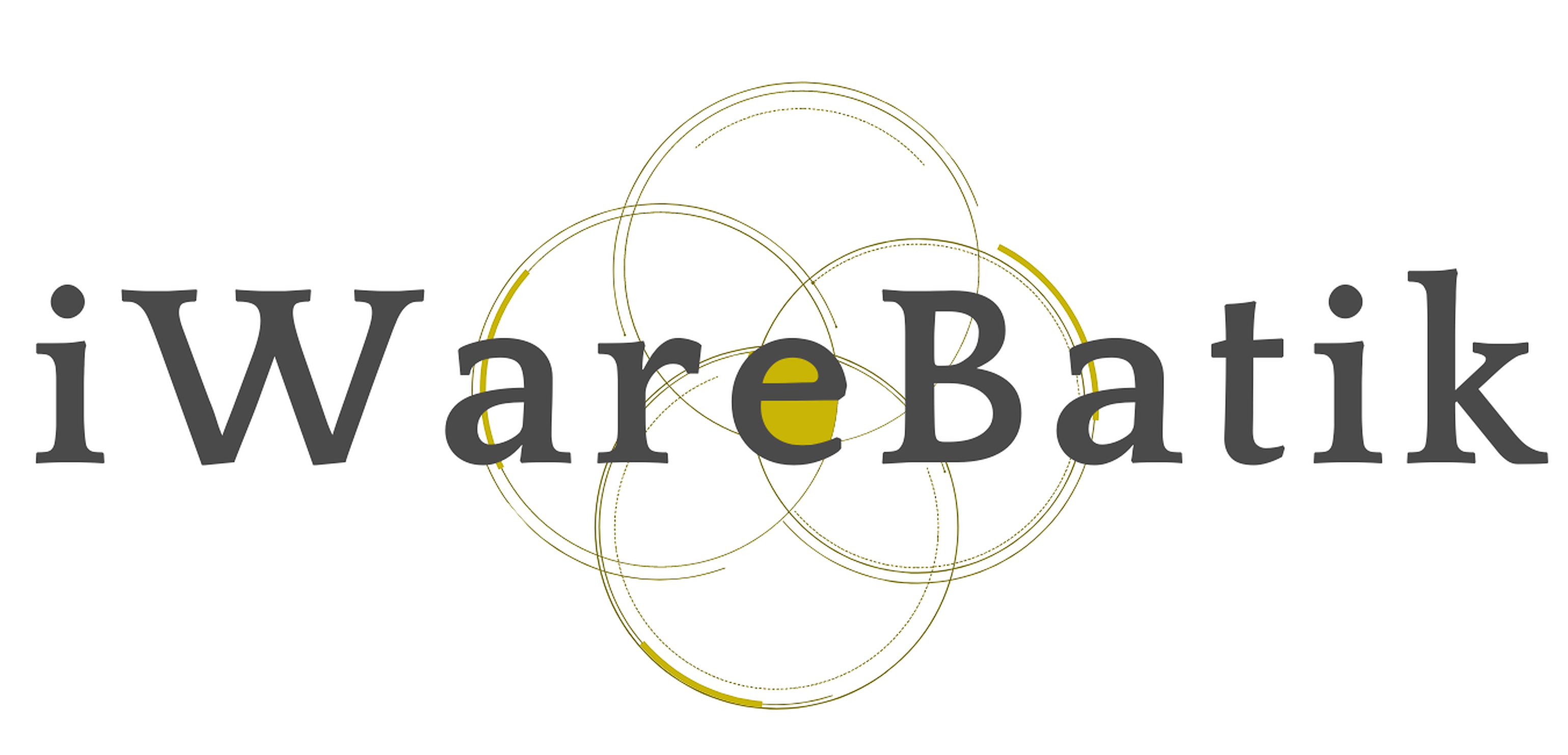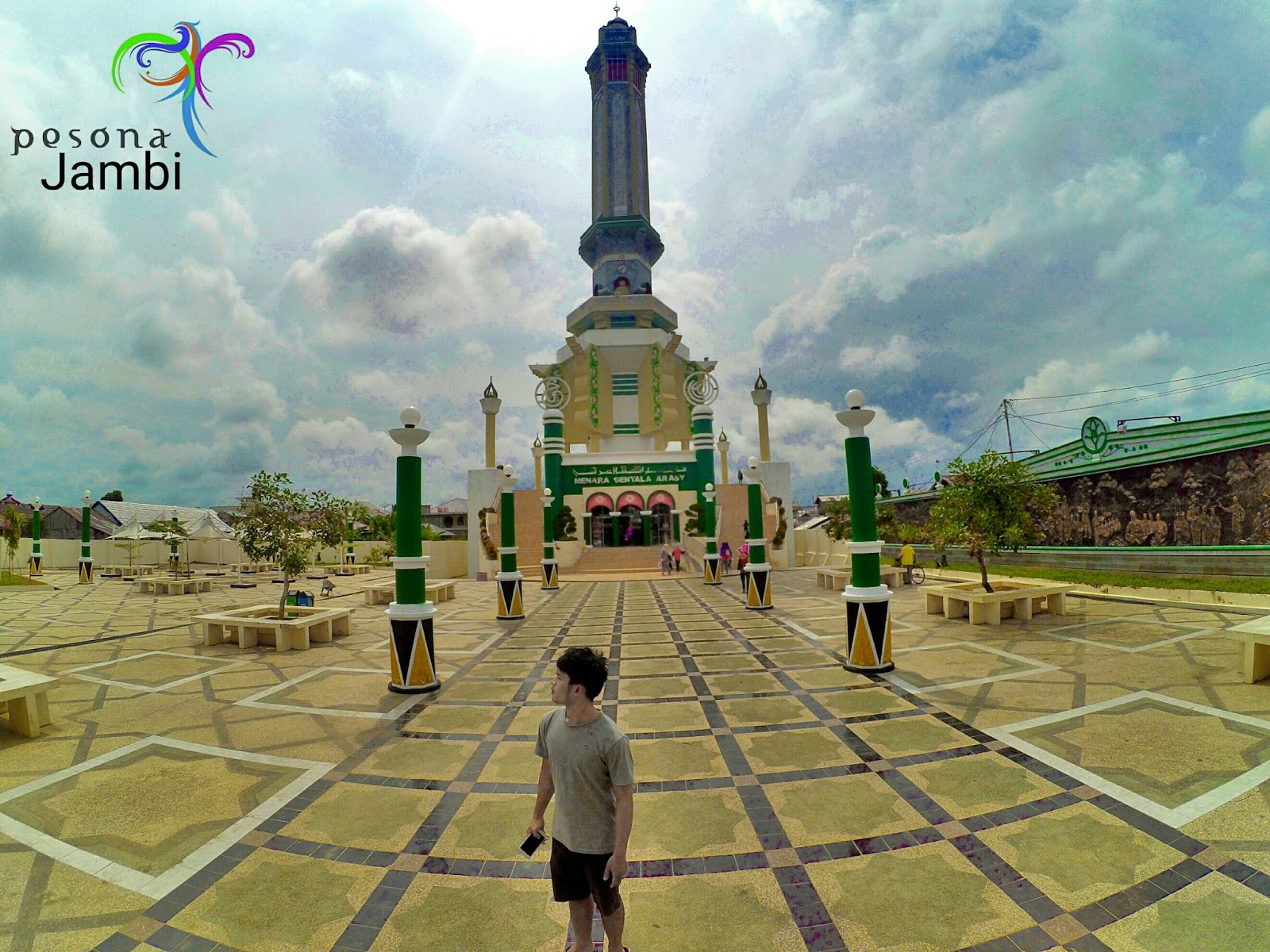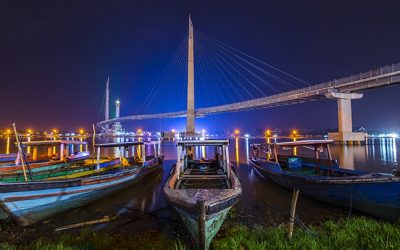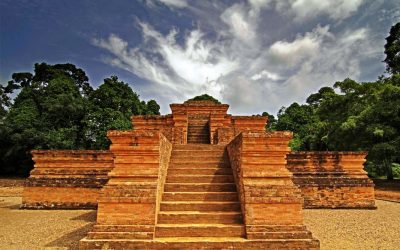Home / Batik Regions – Western Indonesia – Southern Sumatra – Jambi / Gentala Arasy Monument
Cultural Destination
Embrace the spirit of the place!
Gentala Arasy
Gentala Arasy is the iconic landmark of Jambi. This tower is built as high as 80 meters and located in front of the Batanghari Pedestrian Bridge. The tower also highlights the historical perspective of Jambi through the compact packaging of a national museum. Its mini cinema which is placed at the base of the tower also depicts a complete selection of historical documentary films.
Tourist Attractions in Jambi
Batanghari Pedestrian Bridge
Batanghari Pedestrian bridge is also another iconic landmark of Jambi. This bridge was
Muara Jambi Temple
Muara Jambi Temple, built since the 13th Century, is a legacy during the reign of Srivijaya
Jambi
Batik Motifs
Merak Ngeram
The hatching peacock motif has a very deep meaning which refers to the sacrifice and
Durian Pecah
Broken Durian motifs depict the foundation of faith. The second half signifies the mastery of
Angsa Duo
According to legend, the Angso duo batik motif is a pair of swans that are believed to have led Princess
Discover
Indonesian
Batik
Motifs
Angsa Duo
According to legend, the Angso duo batik motif is a pair of swans that are believed to have led Princess
Sandeq
Sandeq Boat is a symbol of the maritime importance of the West Sulawesi region. The greatness of
Durian Pecah
Broken Durian motifs depict the foundation of faith. The second half signifies the mastery of
Prada Papua
The word “Prada” in the Javanese-Indonesian dialect means a batik textile that
Tangerang Herang
Tangerang Herang motif is a symbol of Tangerang city. The Tangerang Herang batik motif consists of
Biji Kopi
The coffee seeds motif illustrates the pride of local coffee specialities in
Ikan tambal
The word “Ikan” refers to fish. The philosophical meaning of Ikan Tambal means is
Gonggong Siput
Gonggong (Strombus Turturella) is one type of sea snail found around
Dayak Kamang
Kamang motif is generally found in the Dayak tribe shield because it is believed to
Bintik Tujuh
The Bintik Tujuh (Seven Dots) motif has 7 white spots and green color gradation as
Cengkeh
The clove flower motif is the main commodity of the Tolitoli Regency. This motif represents
Manguni Minahasa
Manguni is identified as the symbol of the Minahasa people. Manguni is known as a
Sido Mulyo
Sidomulyo is one of the classical motifs, which is specifically used for the bride’s costume in
Merak Ngeram
The hatching peacock motif has a very deep meaning which refers to the sacrifice and
Malinau Cultural Festival
You will witness a unique competition that might not be found other than in
Kasih Tak Sampai
‘Kasih Tak Sampai’ is an idiom in the Indonesian language which refers to
Rangkiang
The word “Rangkiang” refers to the rice granary in the Minangkabau language. It symbolizes
Mahkota Siger
Siger is the crown of a noblewoman in ancient time. It is a symbol of femininity, strength, and
Wirasat
Wirasat or divine inspiration is a gift from God. This inspiration is symbolized by
Lok Baintan Floating Market
As you can imagine, the most authentic thing is that you can buy things and even
Buketan Bali
The Balinese bouquet (Buketan Bali) is a floral arrangement and the name is
Sekar Jati
Sekar means flower and Jati refers to teak trees that symbolizes a strong mental character that
Gigi Haruan Lidi
The Gigi Haruan Lidi motif is taken from the name of the cork fish and is a symbol of
Daun Simpor
This motif is inspired by the Simpor plant (Dillenia Suffruticosa) which is a typical
Gurdo Solo
Gurdo or garuda bird is the mount of the Indian god Vishnu. As the Sun Bird,
Insang Ikan
Insang refers to the gills of the fish. This is a typical pattern of Malay ethnic who inhabits
Rumah Mamuju
the Batik motif illustrates the house of Mamuju King with the stairs, located on the left of the wooden stage house
Gedhog Kembang Waluh
a combination of Javanese cultural motif of the Majapahit kingdom (XII-XIV century) with
Jupri Kembang Teh
Kembang Teh illustrates the tendrils of tea plants that grow in the highlands of
Karawo Mahkuta
Mahkuta refers to Gorontalo’s traditional crown. It represents noble characters of
Kawung
The Kawung motif was created by Sultan Agung Hanyokrokusumo (1593 – 1645) as a symbolic gift for
Lipaq Sabe
Lipaq Saqbe contains a simple geometric classical motif with various flower decorations. This textile is
Tongkonan
Toraja’s traditional house is called Tongkonan. Tongkonan is a place for
Keluak Daun Pakis
The word “Keluak” is a Minang language which means twisted or tangled. The Motif of
Parang Seling
Parang Seling or “alternating daggers” is a royal batik motif. It is a feminine variant of
Gajah Way Kambas
The motif illustrates the Lampung’s natural reserve, the Way Kambas. it also symbolizes
Bekantan Pakis
This motif represents Pakis Haji (Polystichum setiferum), an endemic plant in
Pucuk Rebung Riau
Pucuk Rebung symbolizes heart determination in achieving goals, good luck, and
Kuda Kupang
Horses symbolize wealth. It contains noble values of virtuous characters that bring
Sero Tangga
The Sero Tangga illustrates an endearing feeling and sacrifices of a person to fulfil
Daun Sirih
This motif illustrates betel leaves that are used by Lombok communities as traditional
Tifa Totobuang
The batik motifs illustrate Maluku’s traditional music instrument called
Bale Lumbu
This motif signifies the welfare of the ancient Sasak society. Bale also symbolizes the
Kain Cual
Cual textile tradition has existed since the 17th century. The word “Cual” refers to
Srimanganti
The name of the Srimanganti motif is derived from Palace’s hallway that connects to
Desa Na Tolu
The Desa Na Tolu characteristic pattern symbolizes the Batak philosophy of existence and
Gamolan
This motif illustrates Gamolan, a bamboo musical instrument of Lampung that is
Sekomandi
Its philosophical meaning is the eternal union which refers to a saying “until death do us part”
Pati-Pati Pinehiku
It symbolizes the hierarchy in society and the social status of the Mekongga
Ake Patra
Ake is related to the divinity and the composition of the universe. It is a symbol of
Hiu Taliyasan
Indonesia is also home to the world’s largest fish, the whale shark (Rhincodon typus). Hiu Taliyasan refers to
Kerawang Tegak Aceh
The Vertical Upright (Kerawang Tegak) Motif symbolizes a person who has a strong
Enggang Dayak
Local people beliefs that hornbills are an incarnation of the Commander of the Birds. It has supernatural
Teguh Bersatu
This batik motif shows the strength of the people of Kupang. It also represents a sense of
Pohon Hayat (Tree of Life)
The Batik motifs in Lampung are dominated by the acculturation of Buddhist and
Jumputan Bintang
The word Jumputan means the tie-dye technique, while the word “Bintang” refers to
Pattimura
Pattimura is the name of an Indonesian hero who fought against colonialism in
Bomba Mawar
This motif means sacred love for family, kingdom, and God; It also illustrates
Pinawetengan
The Pinawetengan Batik pattern was taken from a prehistoric inscription in
Singayaksa
The Singayaksa motif comes from the name of a place where Sultan Hasanuddin used to
Kaharingan
The Kaharingan or ‘tree of life’ based on the Dayak tribes’ belief system. This tree symbolizes
Besurek Rafflesia
The term “Basurek” refers to a textile that contains letters or inscriptions
Tubo Kelapa
Coconut tree is a symbol of a good character and strong mentality. It illustrates the more success a person, the more
Gumin Tambun
Based on Hindu mythology, this motif symbolizes lucks, abundant wealth, and
Tengkawang Ampiek
With its many advantages, the Dayaks use this leaf in ritual ceremonies. This plant is a symbol of
Leuit Sijimat
This motif reflects the daily activities of the Baduy tribe in Banten. The main ornaments of batik motif consist of:
Tikar Natuna
The Tikar Natuna motif is adapted from the traditional making of pandanus mats in
Tampuk Manggis Sasirangan
The motif illustrates the philosophy of the mangosteen fruit, which is
Gorga Simeol-Meol
The Gorga Simeol-meol is a pattern of plant tendrils. it is regarded as a symbol of longevity and
Salakanagara
Salakanagara batik motif illustrates the first kingdom in the Betawi land
Lontara
The Lontara script itself is a typical ancient script of Bugis and Makassar communities. History records that
Tanah Liek
The word “Tanah Liek” refers to clay in Minang language. It is also known as
Bultiya
The word ‘Bultiya’ is an acronym of the three major tribes in North Kalimantan, namely





